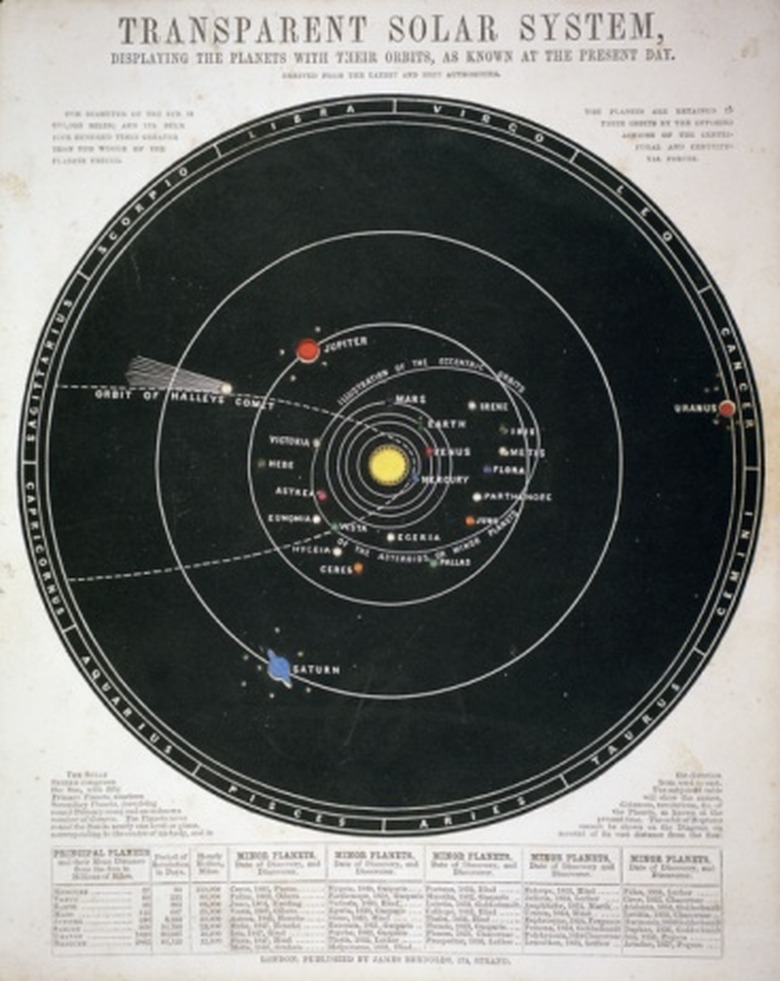How To Calculate A Planet's Revolution Around The Sun
A collaboration between a German astronomer, Johannes Kepler (1571 – 1630), and a Danish one, Tycho Brahe (1546 – 1601), resulted in Western science's first mathematical formulation of planetary motion. The collaboration produced Kepler's three laws of planetary motion, which Sir Isaac Newton (1643 – 1727) used to develop the theory of gravitation.
The first two laws are easy to understand. Kepler's first law definition is that planets move in elliptical orbits around the sun, and the second law states that a line that connects a planet to the sun sweeps out equal areas in equal times throughout the planet's orbit. The third law is a little more complicated, and it's the one you use when you want to compute a planet's period, or the time it takes to orbit the sun. This is the planet's year.
Kepler's Third Law Equation
Kepler's Third Law Equation
In words, Kepler's third law is that the square of the period of any planet's rotation around the sun is proportional to the cube of the semi-major axis of its orbit. Although all the planetary orbits are elliptical, most (except for that of Pluto) are close enough to being circular to allow substitution of the word "radius" for "semi-major axis." In other words, the square of a planet's period (P) is proportional to the cube of its distance from the sun (d):
\(P^2 = kd^3\)
Where k is is the proportionality constant.
This is known as the law of periods. You could consider it the "period of a planet formula." The constant k is equal to 4π2/ GM, where G is the gravitation constant. M is the mass of the sun, but a more correct formulation would use the combined mass of the sun and the planet in question (Ms + Mp). The sun's mass is so much greater than that of any planet, however, that Ms + Mp is always essentially the same, so it's safe to simply use the solar mass, M.
Calculating the Period of a Planet
Calculating the Period of a Planet
The mathematical formulation of Kepler's third law gives you a way to calculate planetary periods in terms of that of the Earth or, alternatively, the lengths of their years in terms of an Earth year. To do this, it's helpful to express distance (d) in astronomical units (AU). One astronomical unit is 93 million miles – the distance from the sun to the Earth. Considering M to be one solar mass and P to be expressed in Earth years, the proportionality factor 4π2/ GM becomes equal to 1, leaving the following equation:
\(\begin{aligned}
&P^2 = d^3\)
\(&P = \sqrt{d^3}
\end{aligned}\)
Plug in a planet's distance from the sun for d (in AU), crunch the numbers, and you'll get the length of its year in terms of Earth years. For example, Jupiter's distance from the sun is 5.2 AU. That makes the length of a year on Jupiter equal to:
\(P=\sqrt{(5.3)^3}=11.86\text{ Earth years}\)
Calculating Orbital Eccentricity
Calculating Orbital Eccentricity
The amount a planet's orbit differs from a circular orbit is known as eccentricity. Eccentricity is a decimal fraction between 0 and 1, with 0 denoting a circular orbit and 1 denoting one so elongated it resembles a straight line.
The sun is located on one of the focal points of each planetary orbit, and in the course of a revolution, each planet has an aphelion (a), or point of closest approach, and perihelion (p), or point of greatest distance. The formula for orbital eccentricity (E) is
\(E=\frac{a-p}{a+p}\)
With an eccentricity of 0.007, Venus' orbit is closest to being circular, while Mercury's, with an eccentricity of 0.21, is farthest. The eccentricity of Earth's orbit is 0.017.
Cite This Article
MLA
Deziel, Chris. "How To Calculate A Planet's Revolution Around The Sun" sciencing.com, https://www.sciencing.com/calculate-planets-revolution-around-sun-8472620/. 16 December 2020.
APA
Deziel, Chris. (2020, December 16). How To Calculate A Planet's Revolution Around The Sun. sciencing.com. Retrieved from https://www.sciencing.com/calculate-planets-revolution-around-sun-8472620/
Chicago
Deziel, Chris. How To Calculate A Planet's Revolution Around The Sun last modified August 30, 2022. https://www.sciencing.com/calculate-planets-revolution-around-sun-8472620/
